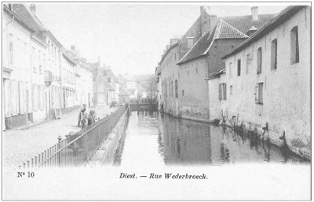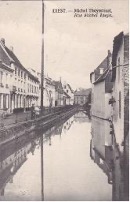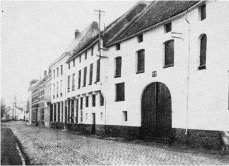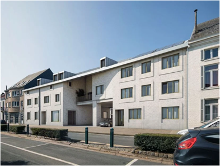By Henri Cosemans
In the heart of Diest, Belgium, lies a street that tells a tale of transformation: one that reflects the shifting tides of history and urban development. The Michel Theysstraat (formerly Wederbroeck), a place that was once bustling with the aroma of a multitude of breweries, has evolved into a desolate, asphalted landscape. Its heritage buildings, now in a state of decay, stand as silent witnesses to a bygone era. This blog post explores how the Wederbroeck became the Michel Theysstraat, from its historical roots to contemporary changes, and ultimately, the potential for preserving its rich legacy in the future.
“ Il se brasse à Diest une bière mousseuse et pétillante; …
on la sent dans l’air, comme une perpétuelle vapeur d’ivresse qui, au moment des brassins surtout, grise le cerveau. ” (Lemonnier, 1888).


Figure 1 & 2. The historic condition of Wederbroeck street, current Michel Theysstraat in Diest, Belgium.
About this Blog series & the Heriland Blended Intensive Programme
The Blogs in this series (March-July 2024) were written by graduate students and early career professionals who participated in the Heriland Blended Intensive Programme “Heritage and the Planning of Landscapes” in October 2023 in Amsterdam, The Netherlands.
Are you interested in participating in the next iteration of the Heriland Blended Intensive Programme, “Heritage and Landscape Futures”, in Gothenburg, Sweden, in October 2024? Visit: Heriland Intensive Blended Program- Heritage and Landscapes Future
or contact Niels van Manen: n.van.manen@vu.nl
A Historically Significant Site
The street’s story begins centuries ago, during the Middle Ages when Diest was a thriving city. Breweries, a cornerstone of the local economy, were established in the area. By the 17th century, the brewing industry flourished, with numerous breweries lining the street. A street whose landscape completely reflected this business through its infrastructure. What typifies the structure of the landscape is the row of houses on the northern side, while the southern side is occupied by an offshoot of the river Demer. The few houses on the southern side were connected to the land by bridges. The water running through the street was essential for the production of beer.
In the 19th century, the Michel Theysstraat was the ultimate heart of Diest’s beer production. The street suffered from its success, becoming too small. This led to breweries branching out to outside the city walls and thus the beginning of the loss of the street’s character.
The Shifting Landscape
Following the 19th-century trend, further decline of the industry in the 20th century cast a shadow over this once-vibrant street. The last major brewery shuttered its doors in 1979, marking the end of an era. For the first time in centuries, the streets of Diest were bereft of its iconic brewing tradition.
Today, a lack of legal protection results in a significant loss to the historical fabric of the industrial site of the Wederbroeck. Just one of many tragic examples is the house adjacent to the Brouwketel brewery. It was acquired by a real estate developer, and over the years, multiple renovation requests were denied, leading to the deterioration of the property. We speak of the Halve Maene brewery, constructed in 1666, making it one of the oldest breweries on the street. Despite its status as architectural heritage and recognition as part of the protected cityscape, the building was not afforded protective measures. In 2018, it was demolished due to structural instability, erasing this segment of history from the brewing centre (Van de Weyer, 2018). In 2021, modern apartment buildings devoid of any reference to the industrial character or history of the street, stand in their place. All of this happens while, not far away in Leuven, international awards are received for the redevelopment projects of former breweries, and the beer culture is acknowledged as an intangible heritage in Belgium (Debo, 2019).


Recommendations for the Future
The evolution of the Michel Theysstraat struggles to balance the demands of the past with the needs of the present.
One brewery on the Wederbroeck is still operational as a brewery today. Notably, the original brewery buildings have been preserved. The exact founding date of De Brouwketel is unknown, although records in the notarial records appearing in the Schepenprotocollen of Diest mention two sales of the entire brewery with its contents (reference). Therefore, it certainly dates back to the end of the 18th century or earlier. After changing ownership several times, the brewery’s operations ceased in 1973 (Leo Mees, 2013). In 1995, the brewery was revived under the name Loterbol, and beer production resumed on a small scale. Despite being a historical industrial complex in the heart of the city — a living history where the craftsmanship that contributed to Diest’s urban development is still practised — this complex is neither recognised nor protected in any way. To preserve the historical brewing industry, this existing brewery needs to be acknowledged as cultural heritage and afforded protections. These protections need to apply to the buildings on the site as well as the intangible aspect of brewing.
The old and new need to be synergised. We cannot neglect the need for new housing development, but it needs to be integrated into the historical fabric of the street. Cultural heritage tourism needs to be encouraged further. The street, and especially the brewery Loterbol, already forms part of the city’s touristic programme.
A very concrete intervention in the landscape that needs to be undertaken is the restoration of the historical presence of water in the cityscape. This has already been done in other parts of the city, but in this street, the Demer still remains asphalted over.
Conclusion
The Wederbroeck slowly evolved into the Michel Theysstraat, which transformed from a thriving brewing hub to a modern, asphalted landscape. The potential for development with attention to cultural heritage is not to be underestimated. By preserving heritage, finding a balance between old and new, and engaging the community, we can breathe life back into the street. Michel Theysstraat, once again, has the potential to become a place that pays homage to its history while adapting to the needs of modern cities.
Bibliography
Lemonnier, C. (1888). La Belgique (Paris: Librairie Hachette, 1888).
Van de Weyer, T. (2018). Bierpatrimonium in diest dreigt te verdwijnen – Brouwerij De Halve Maan binnenkort afgebroken in De Standaard. Accessed on 10th December, 2018;De Halve Maan staat op instorten in Het Laatste Nieuws published on 7th February, 2018. https://www.hln.be/diest/brouwerij-de-halve-maan-staat-op-instorten~a043264a/?referrer=https%3A%2F%2Fwww.google.co.uk%2F
Debo, R. (2019). Brouwerijen in Onderzoeksbalans Industrieel Erfgoed (Gent: Expertisecel voor technisch, wetenschappelijk en industrieel erfgoed, 2019). https://etwie.be/nl/kennisbank/nieuws/nieuwe-onderzoeksbalans-industrieel-erfgoed
Copie der notarisprotocollen voorkomend in de Schepenprotocollen van Diest, Boek XVII van 15/07/1776 – 04/01/1781 & Boek XVIII van 30/10/1780 – 16/05/1783. Rijksarchief Belgium.
Leo Mees. (2013). Brouwerij De Brouwketel (Diest: Limes Tamera, 2013). https://docplayer.nl/23019916-Brouwerij-de-brouwketel.html
About the author
Henri Cosemans is a PhD candidate in Conservation-Restauration at the University of Antwerp. This Blog post is inspired by his participation in the Heriland Blended Intensive Programme on “Cultural Heritage and the Planning of European Landscapes”, October 2023.
Contact the author: Henri.Cosemans@uantwerpen.be

